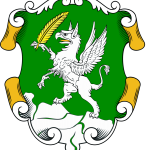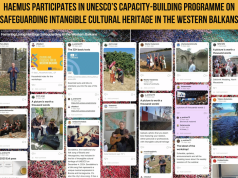
The team of HAEMUS [1. Vasilka Dimitrovska (arheologist), Jelena Jaric (arheologist), Nevenka Atanasoska (sudent of archaeology)] within the project about the ‘Cultural Resource Management of Skopska Crna Gora Mountain’, found new unregistered archaeological site around the toponym Balaklija (Mirkovci village), mostly determined on the base of surface architectonic elements.
Within the St. Elijah monastery, a base of white marble pillar from Late Antique or Medieval building at the floor level of the half-underground church from the Ottoman period was registered. Outside of the monastery in a nearby field, the remains of pottery from the Medieval period can be found. At the corner of the same field, there is dislocated and damaged architectonic element which was a part of some ancient object.
At about 700 m. distance from the St. Elijah monastery, in the courtyard of relatively new St. Virgin Mary church, a large size pillar was used as a decoration of the fence, suggests that it was probably part of big-size object from Late Antique or Medieval period. The configuration of the ground with the remains of a stone structure in the form of a semicircular apse indicates the possible existence of an object of religious character. Surface findings are lacking and without archaeological excavation, it is quite difficult to recognize the character of this building.
In the church beside one of the walls, a capital from Early Christian basilica was found, as a part of a marble architectonic plastic of early Christian period in the Republic of Macedonia The finding is quite damaged and frayed, indicating its secondary use both, as spolia in other later architecture and its usage for various needs and purposes associated with the folklore and beliefs of people, due to the remnants of wax. The capital is massive, heavy and decorated on both sides with different scenes. According to the metrics, shape and oval groove on the upper side, we can assume that it was a part of menno window of early Christian basilica with great dimensions.
Conclusion
According to the archaeological map of the Republic of Macedonia, two archaeological sites in the village of Mirkovcki were recorded. At the toponym Preku Reka (Across the river), with vague geographical reference, a lot of findings from Roman period kept in lapidarium at the Museum of Macedonia were found. North of the village, at the Shumanica toponym, a necropolis of late Roman period was recorded, without precisely description and lack of scientifically publications. In the previous prospecting of this region, archaeologists above the village Mirkovci recorded Late Antique fortification (4th-6th century AD) [2. Information from professor. Dr. Victor Lilcic, director of the Office for the Protection of Cultural Heritage of the Republic of Macedonia].

The latest findings from 2013 suggest the existence of architectural structures from the Late Antique and/or Early Medieval period (Early Christian period), whose elements are used as spolio in buildings from later periods. The presence of capital from early Christian basilica points out at the remains of a large building with a religious character which probably existed at the same time with the city (fortification) and the necropolis.
We are introducing in the scientific literature the archaeological site at the village Mirkovcki under the working title ‘Balkalija’. The full report from the field prospecting was submitted to the Cultural heritage Protection Office of the Republic of Macedonia, City Museum of Skopje and the Skopje’s ConservationCenter. We forwarded sublimated information about the site to the Macedonian press and media.
Director of the field prospecting
Vasilka Dimitrovska, M. Sci. in archaeology
Footnotes:





